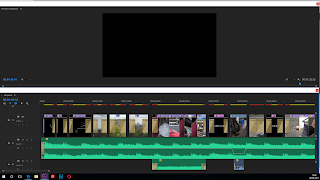The marketing campaign is essential to keep a sense of continuity across all of the media products that are being used to promote the film. This is done because the audience will realise that each text is advertising the same film. A unified campaign helps establish an awareness of the film, showing the potential audience of constant images associated with the film, so that when they make a choice about what to see at the cinema, the film will be fresh in the audience's minds.
All around my campaign I tried to make sure that there were many similar elements. The font used on my teaser trailer and poster, for example, are the same colour but not the same font, making them sort of similar but with the teaser trailer title fading out. This means that when the audience are watching the teaser trailer and looking at the poster they can see that they belong to the same film.
For the magazine cover, I did not use this font as it needed a completely different font, which is different from the film. This is because magazines have their own unique style, that is consistent from their magazine issue to issue - whilst the film companies may be able to influence which image appears on the front cover of a magazine, it is unlikely that they will persuade the magazine publishers to change the font that they use on their front cover.
(image of magazine title)
I also used similar tagline's in my teaser trailer and on my poster which relate to the kind of genre my film is. By having the similar tagline's on the teaser trailer and poster it becomes easy for the audience to associate what the trailer is about while linking it ot the tagline on my poster. The tagline doesn’t give away any extensive detail about the plot, but the small hint may make the audience curious and build anticipation. There is no tagline for the magazine cover, however if there was it would not be the same as the film, it would be something that relates to the magazine emphasising that it is independent from the film.
Tagline from poster:
Taglines from teaser trailer:
However, the main central image used in the poster is not the same as the image I used on the magazine cover, they are both completely different as the magazine cover shows the serial killer and the poster just shows the red hand with a knife. You can tell by this that they are associated with the killer.
I used the same credits/billing on my poster and my teaser trailer. I did not include billing in my magazine as it is not a convention of magazines. Instead, they include cover lines related to features or reviews of forthcoming films. The same goes for production company logos which are featured on my trailer and poster but would not appear on the magazine cover.
The date of release is not the same on my poster and teaser trailer. The magazine’s date is October 13th, tying in with the poster. This will, notify the audience on when the film will be released.
































































